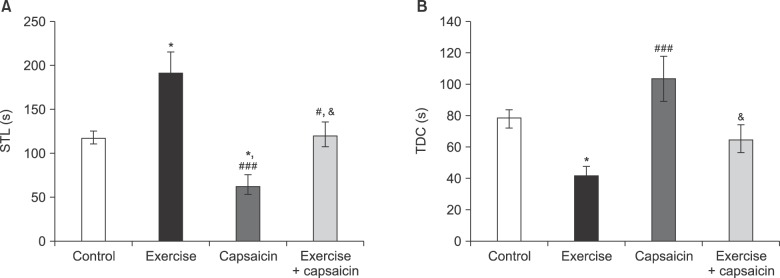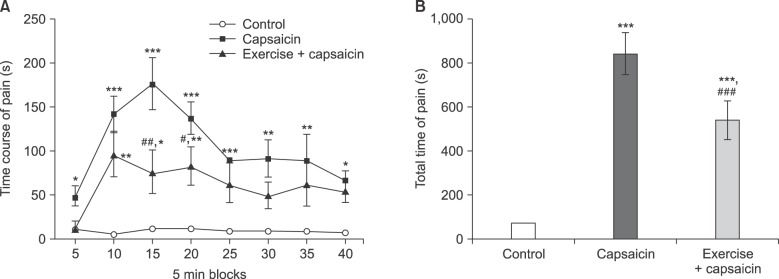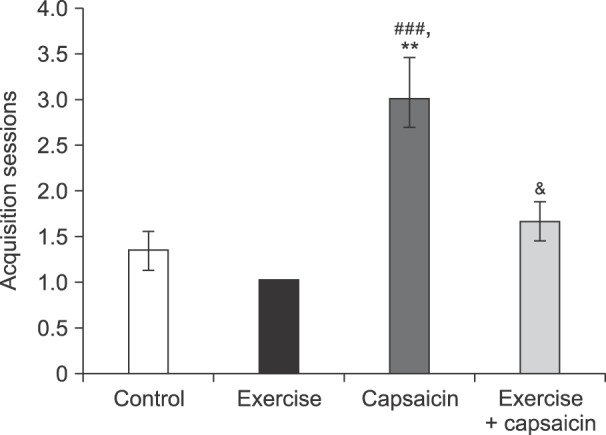1. Lipton JA, Ship JA, Larach-Robinson D. Estimated prevalence and distribution of reported orofacial pain in the United States. J Am Dent Assoc. 1993; 124:115–121.

2. Geurts JW, Haumann J, van Kleef M. Multidisciplinary treatment of orofacial pain. Ned Tijdschr Tandheelkd. 2016; 123:547–551. PMID:
27834409.

3. Sessle BJ. Neural mechanisms and pathways in craniofacial pain. Can J Neurol Sci. 1999; 26(Suppl 3):S7–S11.

4. Venkatachalam K, Montell C. TRP channels. Annu Rev Biochem. 2007; 76:387–417. PMID:
17579562.

5. Huang J, Zhang X, McNaughton PA. Inflammatory pain: the cellular basis of heat hyperalgesia. Curr Neuropharmacol. 2006; 4:197–206. PMID:
18615146.

6. Petersen LJ, Winge K, Brodin E, Skov PS. No release of histamine and substance P in capsaicin-induced neurogenic inflammation in intact human skin in vivo: a microdialysis study. Clin Exp Allergy. 1997; 27:957–965. PMID:
9291295.

7. Nahman-Averbuch H, Dayan L, Sprecher E, Hochberg U, Brill S, Yarnitsky D, et al. Pain modulation and autonomic function: the effect of clonidine. Pain Med. 2016; [in press].

8. Moriarty O, McGuire BE, Finn DP. The effect of pain on cognitive function: a review of clinical and preclinical research. Prog Neurobiol. 2011; 93:385–404. PMID:
21216272.

9. Raoof R, Esmaeili-Mahani S, Abbasnejad M, Raoof M, Sheibani V, Kooshki R, et al. Changes in hippocampal orexin 1 receptor expression involved in tooth pain-induced learning and memory impairment in rats. Neuropeptides. 2015; 50:9–16. PMID:
25817882.

10. Kooshki R, Abbasnejad M, Esmaeili-Mahani S, Raoof M. The role of trigeminal nucleus caudalis orexin 1 receptors in orofacial pain transmission and in orofacial pain-induced learning and memory impairment in rats. Physiol Behav. 2016; 157:20–27. PMID:
26821188.

11. Williamson DJ, Hargreaves RJ, Hill RG, Shepheard SL. Intravital microscope studies on the effects of neurokinin agonists and calcitonin gene-related peptide on dural vessel diameter in the anaesthetized rat. Cephalalgia. 1997; 17:518–524. PMID:
9209773.

12. Parise M, Kubo TT, Doring TM, Tukamoto G, Vincent M, Gasparetto EL. Cuneus and fusiform cortices thickness is reduced in trigeminal neuralgia. J Headache Pain. 2014; 15:17. PMID:
24661349.

13. Wu Z, Qian XY, An JX, Liu CC, Tian M, Cope DK, et al. Trigeminal neuralgia induced by cobra venom in the rat leads to deficits in abilities of spatial learning and memory. Pain Physician. 2015; 18:E207–E216. PMID:
25794221.
14. Weissman-Fogel I, Moayedi M, Tenenbaum HC, Goldberg MB, Freeman BV, Davis KD. Abnormal cortical activity in patients with temporomandibular disorder evoked by cognitive and emotional tasks. Pain. 2011; 152:384–396. PMID:
21167644.

15. Hillman CH, Erickson KI, Kramer AF. Be smart, exercise your heart: exercise effects on brain and cognition. Nat Rev Neurosci. 2008; 9:58–65. PMID:
18094706.

16. Chang YK, Labban JD, Gapin JI, Etnier JL. The effects of acute exercise on cognitive performance: a meta-analysis. Brain Res. 2012; 1453:87–101. PMID:
22480735.

17. Radahmadi M, Hosseini N, Alaei H. Effect of exercise, exercise withdrawal, and continued regular exercise on excitability and long-term potentiation in the dentate gyrus of hippocampus. Brain Res. 2016; 1653:8–13. PMID:
27693393.

18. Kandola A, Hendrikse J, Lucassen PJ, Yücel M. Aerobic exercise as a tool to improve hippocampal plasticity and function in humans: practical implications for mental health treatment. Front Hum Neurosci. 2016; 10:373. PMID:
27524962.

19. Subramaniapillai M, Tremblay L, Grassmann V, Remington G, Faulkner G. The effect of an acute bout of exercise on executive function among individuals with schizophrenia. Psychiatry Res. 2016; 246:637–643. PMID:
27838019.

20. Fuss J, Steinle J, Bindila L, Auer MK, Kirchherr H, Lutz B, et al. A runner's high depends on cannabinoid receptors in mice. Proc Natl Acad Sci U S A. 2015; 112:13105–13108. PMID:
26438875.

21. Stagg NJ, Mata HP, Ibrahim MM, Henriksen EJ, Porreca F, Vanderah TW, et al. Regular exercise reverses sensory hypersensitivity in a rat neuropathic pain model: role of endogenous opioids. Anesthesiology. 2011; 114:940–948. PMID:
21386701.

22. Park SJ. The effects of exercise of diverse intensities on the expression of TNF-α in the spinal cord in osteoarthritic rats. J Korean Soc Phys Med. 2013; 8:539–547.

23. de Moura Guimarães T, Tavares CD, Almeida FR, Cunali PA, Ferraz O, Dal Fabbro C, et al. Mandibular exercises for the prevention of temporomandibular disorder during mandibular advancement device therapy in obstructive sleep apnea patients: a randomized controlled trial. Int Arch Med. 2016; 9.

24. Calixtre LB, Grüninger BL, Haik MN, Alburquerque-Sendín F, Oliveira AB. Effects of cervical mobilization and exercise on pain, movement and function in subjects with temporomandibular disorders: a single group pre-post test. J Appl Oral Sci. 2016; 24:188–197. PMID:
27383698.

25. Zagaar M, Alhaider I, Dao A, Levine A, Alkarawi A, Alzubaidy M, et al. The beneficial effects of regular exercise on cognition in REM sleep deprivation: behavioral, electrophysiological and molecular evidence. Neurobiol Dis. 2012; 45:1153–1162. PMID:
22227452.

26. Jones DM, Arters J, Berger-Sweeney J. Carbon dioxide-induced anesthesia has no effect on brain biogenic amine concentrations in mice. Lab Anim Sci. 1999; 49:316–318. PMID:
10403449.
27. Kohler I, Meier R, Busato A, Neiger-Aeschbacher G, Schatzmann U. Is carbon dioxide (CO2) a useful short acting anaesthetic for small laboratory animals? Lab Anim. 1999; 33:155–161. PMID:
10780819.

28. Pelissier T, Pajot J, Dallel R. The orofacial capsaicin test in rats: effects of different capsaicin concentrations and morphine. Pain. 2002; 96:81–87. PMID:
11932064.

29. Raoof M, Esmaeili-Mahani S, Nourzadeh M, Raoof R, Abbasnejad M, Amirkhosravi L, et al. Noxious stimulation of the rat tooth pulp may impair learning and memory through the induction of hippocampal apoptosis. J Oral Facial Pain Headache. 2015; 29:390–397. PMID:
26485387.

30. Chidiac JJ, Rifai K, Hawwa NN, Massaad CA, Jurjus AR, Jabbur SJ, et al. Nociceptive behaviour induced by dental application of irritants to rat incisors: a new model for tooth inflammatory pain. Eur J Pain. 2002; 6:55–67. PMID:
11888229.

31. Hung CH, Huang PC, Tzeng JI, Wang JJ, Chen YW. Therapeutic ultrasound and treadmill training suppress peripheral nerve injury-induced pain in rats. Phys Ther. 2016; 96:1545–1553. PMID:
27126126.

32. Loyd DR, Sun XX, Locke EE, Salas MM, Hargreaves KM. Sex differences in serotonin enhancement of capsaicin-evoked calcitonin gene-related peptide release from human dental pulp. Pain. 2012; 153:2061–2067. PMID:
22819536.

33. Grace PM, Hutchinson MR, Maier SF, Watkins LR. Pathological pain and the neuroimmune interface. Nat Rev Immunol. 2014; 14:217–231. PMID:
24577438.

34. Leicht CA, Bishop NC. The effect of acute and chronic exercise on inflammatory markers in SCI. In : Taylor J, editor. The physiology of exercise in spinal cord injury. Boston (MA): Springer;2016. p. 217–231.
35. Lee YY, Yang YP, Huang PI, Li WC, Huang MC, Kao CL, et al. Exercise suppresses COX-2 pro-inflammatory pathway in vestibular migraine. Brain Res Bull. 2015; 116:98–105. PMID:
26151770.

36. Koltyn KF. Analgesia following exercise: a review. Sports Med. 2000; 29:85–98. PMID:
10701712.
37. Bement MK, Sluka KA. Low-intensity exercise reverses chronic muscle pain in the rat in a naloxone-dependent manner. Arch Phys Med Rehabil. 2005; 86:1736–1740. PMID:
16181935.

38. Su CF, Chang YY, Pai HH, Liu IM, Lo CY, Cheng JT. Mediation of beta-endorphin in exercise-induced improvement in insulin resistance in obese Zucker rats. Diabetes Metab Res Rev. 2005; 21:175–182. PMID:
15386812.

39. Dietrich A, McDaniel WF. Endocannabinoids and exercise. Br J Sports Med. 2004; 38:536–541. PMID:
15388533.

40. Bechara RG, Kelly ÁM. Exercise improves object recognition memory and induces BDNF expression and cell proliferation in cognitively enriched rats. Behav Brain Res. 2013; 245:96–100. PMID:
23439217.

41. Sleiman SF, Henry J, Al-Haddad R, El Hayek L, Abou Haidar E, Stringer T, et al. Exercise promotes the expression of brain derived neurotrophic factor (BDNF) through the action of the ketone bodyβ-hydroxybutyrate. Elife. 2016; 5:e15092. PMID:
27253067.

42. Erfanparast A, Tamaddonfard E, Nemati S. Effects of intrahippocampal microinjection of vitamin B12 on the orofacial pain and memory impairments induced by scopolamine and orofacial pain in rats. Physiol Behav. 2017; 170:68–77. PMID:
27998753.

43. Kim SE, Ko IG, Kim BK, Shin MS, Cho S, Kim CJ, et al. Treadmill exercise prevents aging-induced failure of memory through an increase in neurogenesis and suppression of apoptosis in rat hippocampus. Exp Gerontol. 2010; 45:357–365. PMID:
20156544.

44. Phaneuf S, Leeuwenburgh C. Apoptosis and exercise. Med Sci Sports Exerc. 2001; 33:393–396. PMID:
11252065.

45. Esch T, Stefano GB. Endogenous reward mechanisms and their importance in stress reduction, exercise and the brain. Arch Med Sci. 2010; 6:447–455. PMID:
22371784.

46. Greenwood BN, Fleshner M. Exercise, stress resistance, and central serotonergic systems. Exerc Sport Sci Rev. 2011; 39:140–149. PMID:
21508844.






 PDF
PDF Citation
Citation Print
Print




 XML Download
XML Download